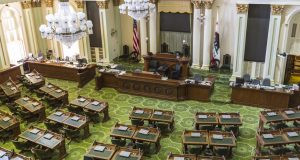By Joe W. Bowers Jr, | California Black Media
On January 10, Gov. Gavin Newsom will present his 2026 budget to the Legislature.
On January 6, he previewed budget highlights while receiving the North San Joaquin Valley’s regional economic plan, a part of California’s broader Jobs First Economic Blueprint aimed at driving local and statewide development.
The proposed $322.2 billion budget, including $228.9 billion in general fund spending, addresses a $2 billion deficit that Newsom is required to balance under state law. The Legislative Analyst’s Office (LAO) notes that while $16.5 billion in additional revenue from a strong economy, stock market gains, and higher tax receipts provides flexibility, long-term structural challenges persist. Spending growth, projected at 5.8% annually, continues to outpace revenue growth of 4%, with deficits potentially reaching $30 billion by 2028-29 without adjustments.
To ensure fiscal stability, Newsom plans to save $1.2 billion over two years by eliminating 6,500 state jobs and cutting $3.5 billion through operational efficiencies like reduced travel and IT modernizations. Despite these measures, Newsom assured there will be no cuts to core programs. Temporary revenue boosts, including $7 billion from stock market-linked income taxes, offer short-term relief but are not sustainable, making California’s $17 billion rainy-day fund a critical tool for managing future fiscal pressures.
This budget will incorporate strategies discussed during a recent special legislative session convened to prepare for potential conflicts with the incoming Trump administration and to safeguard critical state programs against federal interference or defunding.
During the Dec. 2 special legislative session, lawmakers introduced SBX-1 authored by Sen. Scott Wiener (D-San Francisco), which allocates $25 million to the California Department of Justice to cover litigation costs for defending state policies against federal challenges. These funds will support Attorney General Rob Bonta’s office in lawsuits targeting federal actions on reproductive rights, zero-emission vehicle standards, and the Deferred Action for Childhood Arrivals (DACA) program. An additional $10 million is earmarked for county and city legal departments to defend local initiatives.
The budget continues investments in education, healthcare, housing, and economic growth.
In the 2025-26 budget, Proposition 98 funding for K-12 schools and community colleges increases by $1.5 billion, reaching $116.8 billion, with per-pupil spending rising to a record $23,723. Of this amount, $2.8 billion will be available for new commitments, reflecting forecasts for growth and a 2.46% statutory cost-of-living adjustment. Initiatives such as Universal Transitional Kindergarten, expanded after-school and summer programs, and Universal School Meals are expected to strengthen educational outcomes.
Despite this funding boost, inequities persist in educational outcomes for Black students, who face suspension rates nearly three times higher than their peers and lower graduation rates. Discretionary funds could support programs aimed at addressing these disparities, including investments in teacher training, mental health services, and restorative justice initiatives.? In addition, Newsom will fund programs addressing literacy gaps, such as dyslexia screening and high-dose tutoring.
California’s higher education system is expected to benefit from increased funding to support affordability and access across its community colleges, California State University, and University of California systems. The budget will likely emphasize financial aid expansion, enrollment growth for underserved groups, and infrastructure improvements, while aligning educational programs with workforce needs to ensure graduates are prepared to fill existing gaps in the job market.
California’s housing crisis continues to disproportionately affect Black residents. Although Black Californians make up nearly 6% of the state’s population, they represent roughly 50% of its unsheltered homeless population. As of 2024, California’s homeless population exceeded 180,000, reflecting a 31% increase since 2007??.
High rental costs, averaging $2,225 per month for a two-bedroom apartment statewide, contribute to housing instability. The budget is expected to include funding for affordable housing construction, homelessness prevention programs, and emergency rental assistance. However, long-term solutions such as increased funding for affordable housing developments and tenant protections remain critical.
Medi-Cal, which serves over 14 million Californians or about one-third of the state’s population, remains a critical focus area for the budget. With federal funding accounting for 64.4% of Medi-Cal’s budget, potential changes under the Trump administration could pose risks. The state has historically relied on reserves to stabilize Medi-Cal programs during times of uncertainty. Proposals expected in the 2026 budget include expanding access to mental health services, addressing maternal and infant health disparities in Black communities, and increasing funding for community clinics in underserved areas.
Additionally, the budget will likely prioritize environmental justice initiatives aimed at improving air quality and providing safe drinking water in underserved communities, addressing longstanding health and environmental disparities. Public transportation improvements are expected to receive attention as well, enhancing accessibility and economic mobility in Black and low-income communities.
Economic recovery poses significant challenges for Black Californians, who face an unemployment rate of 6.7%, significantly higher than the 3.4% rate for White and Asian individuals and the 5.9% rate for Hispanic or Latino individuals. These disparities underscore the need for workforce development programs, including apprenticeships, small business grants, and enforcement against wage theft.
The California Legislative Black Caucus (CLBC) is anticipated to play an active role in budget negotiations. Historically, the caucus has championed policies that address disparities in education, housing, and healthcare impacting Black Californians.
In the 2026 budget cycle, the CLBC is expected to prioritize equitable distribution of Proposition 98 funds, expanded allocations for affordable housing, and targeted healthcare initiatives to address disparities in underserved communities. With $3.7 billion in the Proposition 98 reserve, discussions may focus on ensuring these funds address inequities affecting Black Californians.
Key dates in the budget process include May 14, when the Governor presents an updated version of the budget incorporating amended revenue forecasts and adjustments. June 15 is the deadline for the final budget passage.
Newsom’s 2026 budget will outline California’s approach to addressing systemic inequities while maintaining fiscal responsibility. The active involvement of stakeholders, including the CLBC, will be pivotal in shaping the state’s response to critical issues impacting Black Californians.
 Westside Story Newspaper – Online The News of The Empire – Sharing the Quest for Excellence
Westside Story Newspaper – Online The News of The Empire – Sharing the Quest for Excellence





